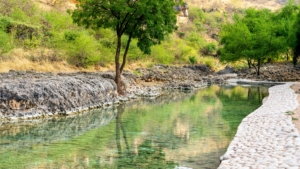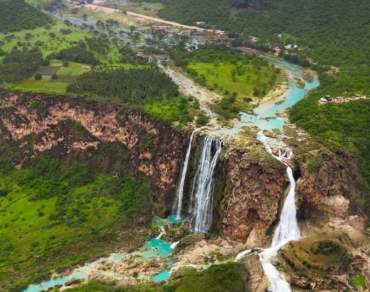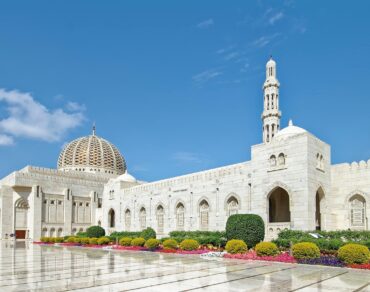
-
Oman Tour Packages > Wiki > Why Ain Razat Salalah Should Be Your Next Natural Escape

Why Ain Razat Salalah Should Be Your Next Natural Escape
Ain Razat Salalah ranks among the world’s most beautiful natural springs that showcase nature’s artistry with crystal-clear waters and stunning landscapes. The natural wonder lies just a 30-minute drive from Salalah’s city center and features an impressive network of 360 permanent and seasonal springs throughout the Dhofar Governorate.
Ain Razat Salalah’s beauty extends beyond its pristine waters. The area boasts a charming public garden with green spaces and colorful roses. Visitors can climb a stone staircase to reach Razat Cave which offers breathtaking views. This destination serves two important purposes – it provides a peaceful retreat for visitors and supplies water to local farms through the traditional falaj irrigation system.
This piece will guide you through everything that makes Ain Razat worth visiting, from its hidden spots and photo opportunities to the perfect times to experience its natural splendor.
The Natural Magic of Ain Razat Salalah
You’ll find Ain Razat 15 kilometers from Salalah’s center in the northeastern part of the Dhofar Governorate. This natural wonder fascinates visitors with its extraordinary features.

Crystal clear springs and pools
The pure water springs emerging from the mountainside create Ain Razat’s magical appeal. The water quality here exceeds expectations – clean enough to drink and ideal for local crop irrigation. These crystal-clear pools are home to native fish species and other aquatic life. The pools showcase beautiful water lilies in white and magenta, which add vibrant colors to the peaceful surroundings.
Ancient limestone caves
Limestone caves at Ain Razat reveal amazing geological stories. Stone staircases built by the Dhofar Municipality make these natural formations available to visitors safely. Stone benches at the cave entrance let visitors enjoy panoramic views of the surrounding landscape. Photographers love this spot because the cave system’s natural formations and dramatic mountain backdrop create breathtaking views.
Year-round flowing water
The continuous water flow throughout the year makes Ain Razat truly special. Water from the spring runs through a traditional falaj system for 7 kilometers to Al-Mamurah Palace and another 3 kilometers to Razat Farm. The water levels rise by a lot during autumn as rainfall collects in the surrounding mountains. This spring belongs to an impressive network – the Dhofar Governorate has 360 permanent and seasonal springs that stretch from the Wilayat of Shalim and the Al-Halaniyat Islands in the east to the Wilayat of Dhalkut in the west.
The public garden at Ain Razat shows nature’s abundance with:
- Lush green spaces with a variety of tree species
- Colorful roses and seasonal blooms
- Multiple streams create a picturesque setting
- Shaded areas are perfect for relaxation
Best Times to Experience Ain Razat
Your experience at Ain Razat depends on when you choose to visit. Each season brings its own charm as the spring’s character changes throughout the year.

Peak season during Khareef
The monsoon season, known as Kharee,f turns Ain Razat into a green paradise from late June to mid-September. Temperatures stay cool at 20°C to 26°C, which makes it perfect for exploring outdoors. The monsoon rains raise the water levels and create an amazing sight.
The peak season buzzes with activity and you’ll find:
- Fresh fruit and ice cream at makeshift stalls
- Kites and traditional toys from local sellers
- Springs filled with more water
- Green vegetation everywhere
You can visit the garden daily between 2 PM and 6 PM during this time. The crowds get bigger in July and August as visitors from all over the Middle East come to escape the heat.
Off-season tranquility
The shoulder seasons of April-May or October-November give you a quieter experience. The spring keeps flowing with less force, and the weather stays nice enough for outdoor activities.
The winter months from December to February have their own appeal with temperatures between 22°C to 28°C. The garden opens only on weekends from 9 AM to 6 PM during these off-peak months. You’ll find fewer tourists and a more peaceful atmosphere.
October and November mark the transition from monsoon weather, and temperatures stay between 24°C to 30°C. This makes it a great time to visit if you want nice weather without the crowds.
Hidden Spots Most Visitors Miss
Ain Razat Salalah holds many hidden gems that await adventurous visitors beyond its popular spots.
Secret viewpoints
The Matam Arzat viewpoint gives you an unmatched panoramic vista of Salalah’s cityscape. The As San Valley shows off breathtaking views of the Razat Valley, where crystal-clear waters flow through the lush landscape. These high points make perfect spots for sunrise photography and bird watching.
Lesser-known walking trails
You’ll find several unmarked paths in the surrounding area that lead to amazing discoveries. These hidden trails include:
- Wadi Hinna Valley: A peaceful route with ancient baobab trees and secluded springs
- Mountain Base Trails: Paths that wind through rugged terrain and show glimpses of various bird species
- Valley Bottom Track: A peaceful walk next to the spring’s water channels
Quiet meditation corners
The limestone cave system has the most peaceful spots for reflection. A stone staircase takes you to several secluded corners where you can find solitude. The garden area has hidden nooks under shade trees that see few visitors during off-peak hours. Water flows gently in the background, creating a perfect setting for peaceful contemplation.
Local fishing spots
Fishing enthusiasts will love Ain Razat’s unique freshwater fishing opportunities. The clear pools are home to various fish species, making them ideal spots for recreational fishing. You’ll find the best fishing spots along the extended water channels, especially in the early morning hours.
The hidden spots’ surroundings showcase rich biodiversity. Various tree species and plants thrive in this unique microclimate. Visitors might spot local wildlife, including different bird species that call these secluded areas home. The mix of green spring areas and rugged mountains creates countless unofficial viewpoints. Each spot offers its own unique view of this natural wonder.
Photography Guide to Ain Razat
Timing and location choices are crucial for photographers who want to capture Ain Razat’s natural beauty. Note that the interplay of light and shadow on the water creates stunning photographic opportunities throughout the day.
Morning light spots
Ain Razat offers its most favorable photography conditions during early morning hours. The soft morning light lights up:
- The crystal-clear pools with their water lilies
- The limestone cave entrance with its dramatic shadows
- The flowing streams against the mountain backdrop
- The garden’s vibrant roses and seasonal blooms
The morning golden hour, right after sunris,e bathes the landscape in warm, gentle light. Photographers can capture the water’s natural clarity and subtle morning mist that hovers over the springs during this time.
Sunset locations
The late afternoon golden hour presents another prime window for photography. You’ll find an excellent sunset spot at the cave viewpoint that offers panoramic views of the surrounding landscape. The stone staircase to the cave gives unique vantage points to capture the changing light on the water below.
Magic happens just before sunset when:
- Mountain shadows cast dramatic patterns across the water
- Garden foliage takes on rich, warm tones
- Flowing streams reflect the golden light
- The cave entrance frames the setting sun perfectly
Light changes faster during sunset and requires quick camera setting adjustments. You’ll get the best results near water features where light and water create mesmerizing effects. Make sure to arrive an hour before sunset to scout locations and set up equipment.
The mountain backdrop provides a majestic frame for photographs during both morning and evening sessions. Traditional falaj irrigation channels add unique compositional elements, especially during golden hours when the water seems to glow.
Local Stories and Legends
The enchanting springs of Ain Razat have shaped Omani culture through generations, with stories that echo through time.

Ancient tales of the springs
Life flourished around these vital waters in an ancient settlement, and its story lives on. Today, old foundations and walls stand as silent witnesses to a bustling past. Our ancestors built an ingenious falaj irrigation system that shows their remarkable engineering skills in managing water in this dry region.
A fascinating network of channels, both above and below ground, reveals how people adapted to their environment. The system works through several key parts:
- Water emerges from the aflaj (source points)
- Dawas (distribution channels) carry water to the fields
- Water stays cool in underground passages
- Smart distribution points serve different areas
Historical significance
Ain Razat means more than just natural beauty. These springs have given life to countless generations and shaped how people farm their land. The traditional falaj system still plays a key role today, as farmers manage to keep their channels flowing with fresh water.
These springs have helped sustain life throughout the Dhofar region. The water quality remains pure enough to drink and perfect for irrigation. This reliability makes Ain Razat one of Oman’s most abundant water sources.
Modern-day beliefs
Local people believe strongly in Ain Razat’s healing powers. Many say the spring water can cure ailments, a belief that families have passed down through time. The springs hold deep spiritual meaning for Omanis, beyond their natural wonder.
Visitors can explore Salalah’s heritage through these springs. Local artists gather here to show their traditional crafts and keep old customs alive. The place feels like a living museum where people experience true Omani hospitality and traditions.
White and magenta water lilies float on the spring’s surface, holding special meaning in local culture. These flowers grow only in Ain Razat among all Dhofar’s springs, making the site unique. Clear waters teem with fish that locals say have lived here for generations, adding to the spring’s mysterious appeal.

Conclusion
Ain Razat Salalah shows nature’s artistry at its best. The place combines pristine waters, ancient caves, and rich cultural heritage. We found this natural wonder changes with the seasons – from the vibrant Khareef months to the quiet winters.
The stunning springs and traditional falaj system make this place special. Hidden trails and secret viewpoints create a unique experience each time you visit. The golden light at dawn and quiet meditation spots let visitors connect with a place where natural beauty and history come together.
Spring’s stories and legends make the experience even more magical. Ain Razat’s role in local farming shows how important it remains today. The mix of natural beauty, photo spots, and cultural value makes this place a must-visit for anyone who wants to see Oman’s finest natural wonders.
The crystal-clear waters and lush gardens show that some places keep their natural charm forever. A trip to Ain Razat goes beyond nature – it lets you explore Omani heritage while enjoying cool mountain breezes and the soft sounds of flowing springs. From wish list to boarding pass, add the tranquil beauty of Ayn Razat to your East Salalah tour and discover the lush heart of Dhofar’s nature.
Related Tours
Related Tours
Test2
© 2025 Oman Tour Packages. All rights reserved.



